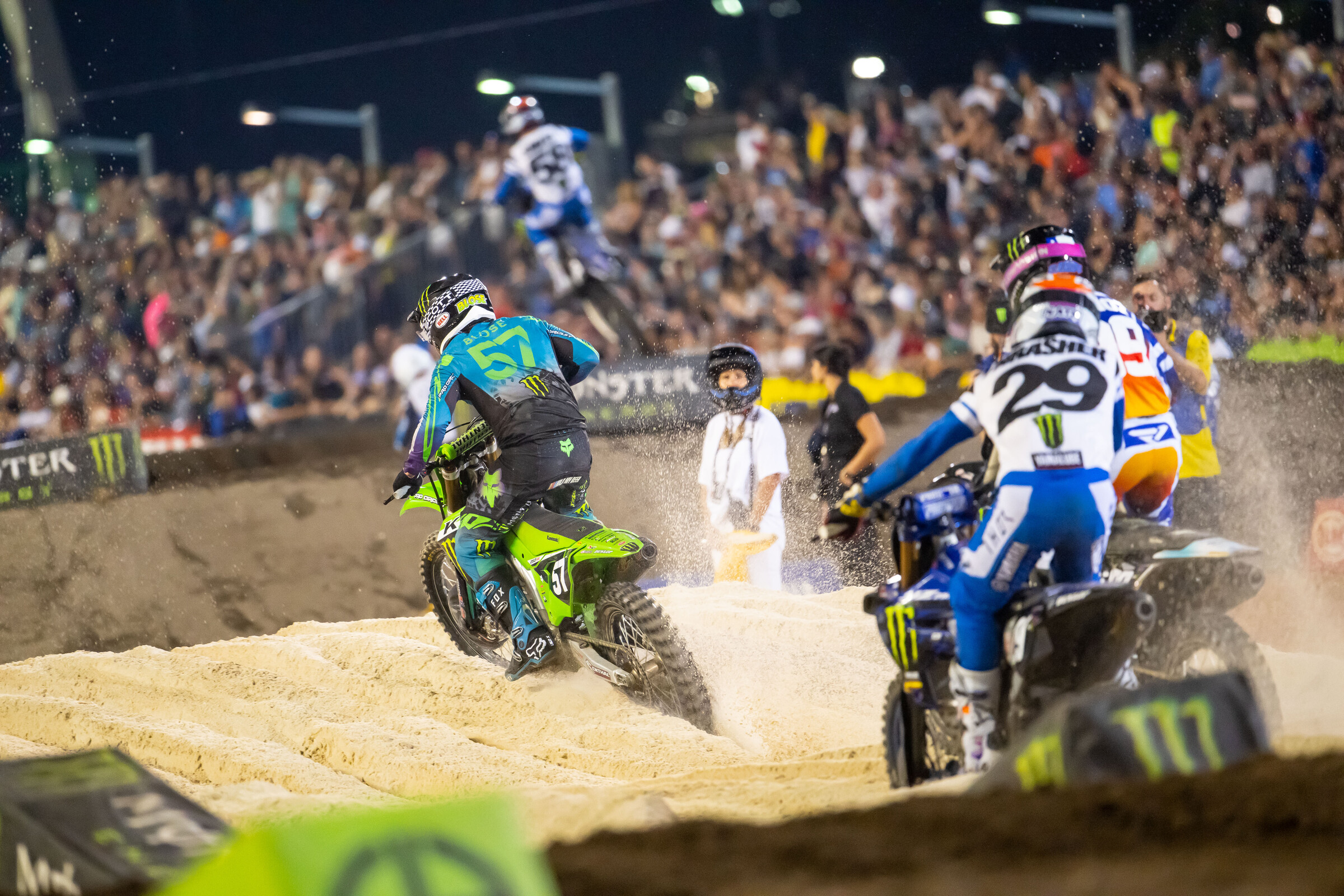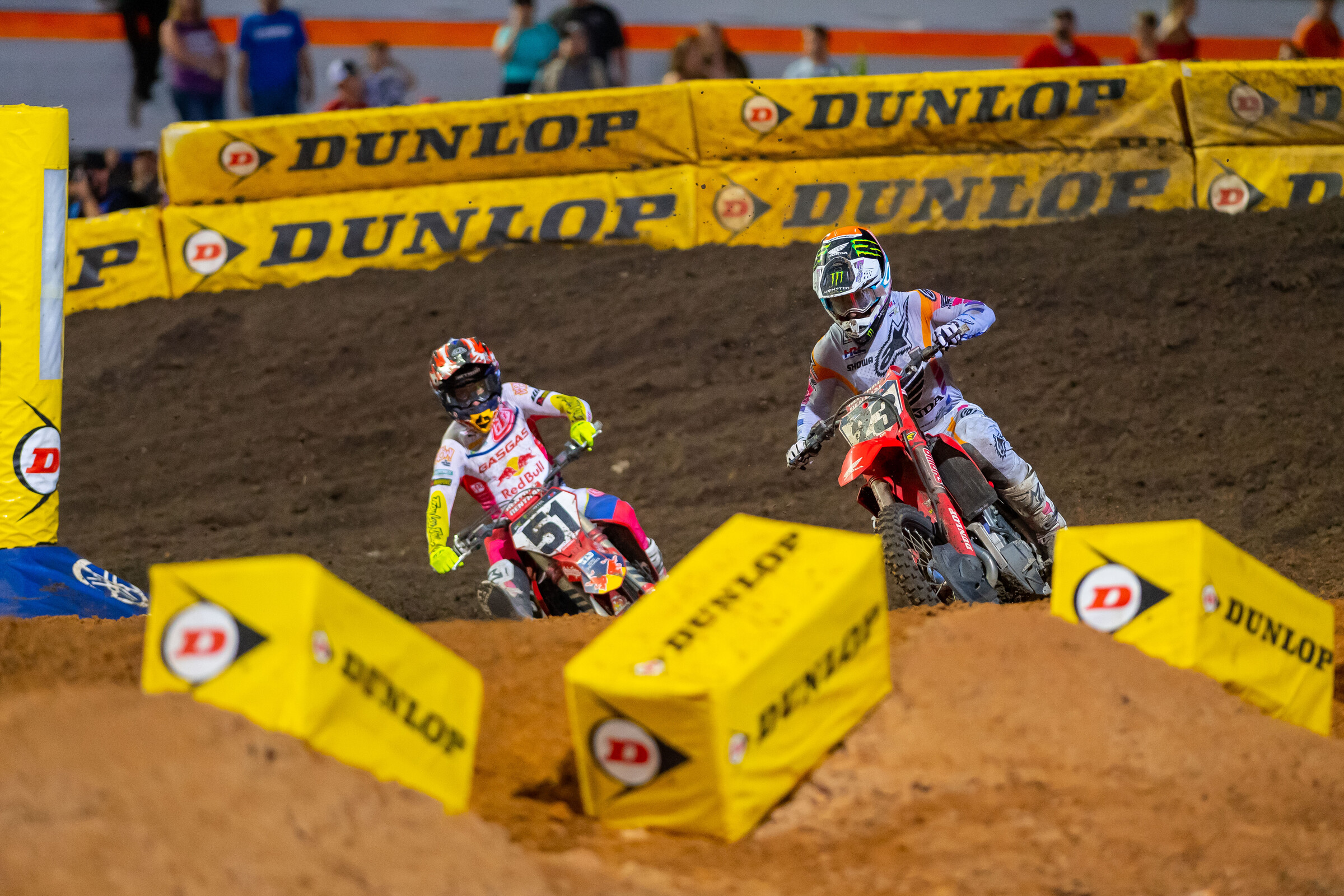The eighth round of Monster Energy AMA Supercross went down over the weekend in Daytona, Florida, and what a night it was! Everything from takeouts, rookie debuts, and a thrilling dogfight up front in the 450SX class was on display at the most prestigious race of the season. To get a more detailed look, we leaned on former pro Jason Thomas to offer some insights from the race.
Eli Tomac and Cooper Webb came into Daytona separated by just two points, meaning whoever won was going to take sole possession of the red number plate. Is this something that specifically goes through their minds out there? If so, is it enough to give either rider that extra boost of motivation?
I don’t believe that was as big of a factor as it being Daytona itself. Webb has never won Daytona while Tomac had won six prior times. The mental messaging up for grabs was more important than the short-term points. If Webb could grab his first ever Daytona win by beating Tomac straight up in a dogfight, that would be hard for Tomac to swallow. It didn’t go that way and Tomac made it seven, but that would have been a pivotal turn in momentum.
What a ride from RJ Hampshire in his first 450SX appearance! Did you see his heat race win, or his ninth place, in the cards beforehand?
A ninth in the main event is in the range I had him, as long as he didn’t crash. Looking at the field minus Joey Savatgy, Adam Cianciarulo, and Dylan Ferrandis, I thought he could land inside the top 10. He’s a Floridian and would be comfortable in the sand/clay mix that Daytona offers.
The heat race win was a whole different story, though. To lead wire-to-wire, besting Cooper Webb in the form he’s been on was very impressive. Don’t forget, he also beat Jason Anderson and Chase Sexton in that same heat race, meaning he beat three out of the top five in points in his very first 450 heat race. Rides like that can make you a lot of money if you’re in a contract negotiation.
The track in Daytona claimed more victims than Bernie Madoff. Was it about normal for Daytona, or was the casualty rate a little higher this year? What was it about the track that had led to so many riders taking soil samples?
Daytona has seen about every variation possible. Years ago, Daytona was a brutal mix of sand, clay, and limestone. The ledge bumps in the transitions were enough to flatten rims. Starting in the early to mid-2000’s, that transitioned to a more traditional SX feel. Lots of orange clay was brought in to build a clay base instead of the black sand that was Daytona. That kept the track more manageable, and riders stuck with their SX settings. The last couple of years have seen a slow transition back to sandier conditions. Simply looking at pictures of a race from say, 2005, and then looking at 2023 would be a stark difference in soil color. The darker the soil, the rougher and ruttier the track will get. The black sand breaks down very fast and bumps form quickly. As that deterioration occurs, the track gets more treacherous.
The final difficulty came in the build this year. There were several big rhythm sections that asked riders to triple and quad. When those get rutty, things will often go sideways. Daytona’s soil was softer, and the jumps were more technical this year. That’s a very tricky combo to navigate.
What do you make of the action between Chase Sexton and Justin Barcia? Was Sexton’s move-over on Barcia anything to get worked up over? Was Barcia’s move later on, in which he bumped into Sexton and went down himself, warranted?
That was a wild sequence. I went back and watched it a few times and Barcia definitely has reason to be upset. Chase moved toward Barcia over those final few jumps leading to the main triple, leaving Barcia nowhere to go and eventually forcing contact. I believe Sexton was trying to squeeze Barcia in order to hold him behind him, but Barcia was committed already.
Barcia was angry and rightfully so. When Sexton made another mistake and opened the door for Barcia up that inside, he went for it. Again, he got the short end of the stick, but I believe anger and emotion was a factor in pushing that angle. No one likes being cross jumped, even Barcia who can’t ever complain about iffy tactics being employed.
Sexton was doing everything possible to stay in the fight for the win and letting Barcia by would have been a death knell to that. I don’t condone the move but there is a lot of urgency and emotion influencing these immediate decisions. It’s easy to Monday morning quarterback these things after analyzing them for a day or two.
While we’re talking about dustups, how about Hunter Lawrence’s move on Nate Thrasher? Did he need to get so aggressive so early in the race? Is he thinking about the championship in these situations? How much blame does Thrasher deserve for leaving himself open in that turn?
He’s been very aggressive in these situations, hasn’t he? I don’t know if he is specifically going for the takeout, per se, as he is just trying to be the aggressor in every dynamic. Looking back at his move on Mosiman in Tampa and this one on the opening lap in Daytona, he doesn’t seem to have an issue with going in hard and seeing what happens. The interesting thing will be if and when the shoe is on the other foot, and he loses valuable championship points. Will it seem like the prudent move then? Can anyone return the favor?
I don’t fault Thrasher here. He was trying to swing wide to make a run on Tom Vialle. That outside had been working throughout the night, allowing riders to pull alongside and slingshot past exiting the sand. He couldn’t have known Hunter would go for the jugular there.
Chris Blose quietly had an extremely solid night, taking seventh. Was there something about the track that suited him, did his veteran experience kick in, or is he just getting more used to his Monster Energy Pro Circuit Kawasaki ride?
I think it was a mixture of avoiding serious drama and also experience. There were riders having huge crashes all around him and he just stayed the course. He, Chance Hymas, and Coty Schock all had similar rides that way. Hymas came from further back, but they all just put in steady laps and were rewarded with top 10s for their trouble.
The sand section was huge and looked brutal. It seemed like going outside was the fastest line, but what about when you’re right on the rear wheel of someone? Is the fast line still fast when you’re getting absolutely sandblasted?
I think the move was to simply go where the lead rider wasn’t. If they went outside, you go inside. The priorities were two-fold. First, being able to see where you’re going is mandatory. It was so easy to make a mistake there and blindly putting the front wheel wrong would usually end poorly. Second, it was very difficult to make a pass unless you went to the alternate line (don’t tell Hunter this, though). Riders never want to follow as a general rule, but the sand was an extreme example of this.







